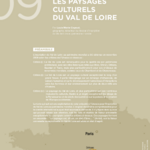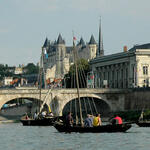- Resources
- Bibliographie et documents
- Home
- Act
- Guide pratique - Val de Loire patrimoine mondial et aménagement du territoire
- A remarkable heritage site
A remarkable heritage site
Published on 14 November 2018 - Updated 13 December 2019
Remarkable heritage sites (SPR) maintain and enhance town and village sites in the Loire Valley whose compositional and architectural quality are a key component part of the OUV. SPRs go hand-in-hand with listed sites, thereby addressing the World Heritage considerations of large areas like the Loire Valley.
To know...
- Le site patrimonial remarquable en quelques mots
- Le site patrimonial remarquable (SPR) permet de comprendre, faire connaître, et réglementer l’implantation, la forme, le traitement des façades, les matériaux des constructions et plus précisément les éléments comme :
- L’organisation de l’habitat et des jardins en séquence entre coteau et fleuve ;
- La typologie des maisons, élancées en hauteur et longueur, à pignons étroits, couvertes d’un toit à deux pans pentus ;
- La composition des façades (baies plus hautes que larges, bardages à lames verticales) ;
- Les matériaux utilisés (pierre de taille en tuffeau, enduit à la chaux et sable d’extraction locale, bois, ardoise, petites tuiles plates).
- À défaut de procédure de site classé, les espaces ruraux et les paysages qui forment avec le patrimoine bâti un ensemble cohérent, susceptibles de contribuer à leur conservation ou leur mise en valeur peuvent être englobés dans le SPR. Un règlement adapté intégrera la valorisation de ces espaces, notamment à l’échelle du grand paysage et des perspectives.
Over
90%
of local authorities in the Loire Valley have pledged to include the notion of World Heritage in their urban planning documents
Link experiences
The Amboise area for enhancing architecture and heritage (AVAP)
2011 - 2016
Drafting a World Heritage section in the AVAP has simplified the regulatory t...
Read moreHow to ?
- Call on a multidisciplinary team including a heritage architect, urban planner and landscape designer.
- Define precise rules: these do not amount to a charter but to a regulatory tool containing a set of requirements – rather than mere recommendations or guidelines.
- Include a thought process on the energy performances of old buildings, and more generally how to adapt these responsibly to their environment and to the current standards of comfort and new uses.
- Bring residents on board (through workshops, exhibitions or public debates for example) for a participatory process grounded in meaningful local values.
- Ensure continuity in the way projects are explained and presented: even the best-designed tools, if poorly applied, will not lead to the desired outcome. Explanations and monitoring are delivered at local level drawing on the skills of a landscape architect/consultant and those of trained management structures.




![Nouvelles Renaissance(s] 2023](/var/storage/images/val-de-loire-refonte/dossier-de-parametrage/pied-de-page/nouvelles-renaissance-s-2023/517479-13-fre-FR/Nouvelles-Renaissance-s-2023_image_largeur220.png)


 Lettre d'information
Lettre d'information
 Facebook
Facebook
 Flickr
Flickr
 Podcloud
Podcloud
 Dailymotion
Dailymotion
 Box
Box
 Slideshare
Slideshare
 Diigo
Diigo

